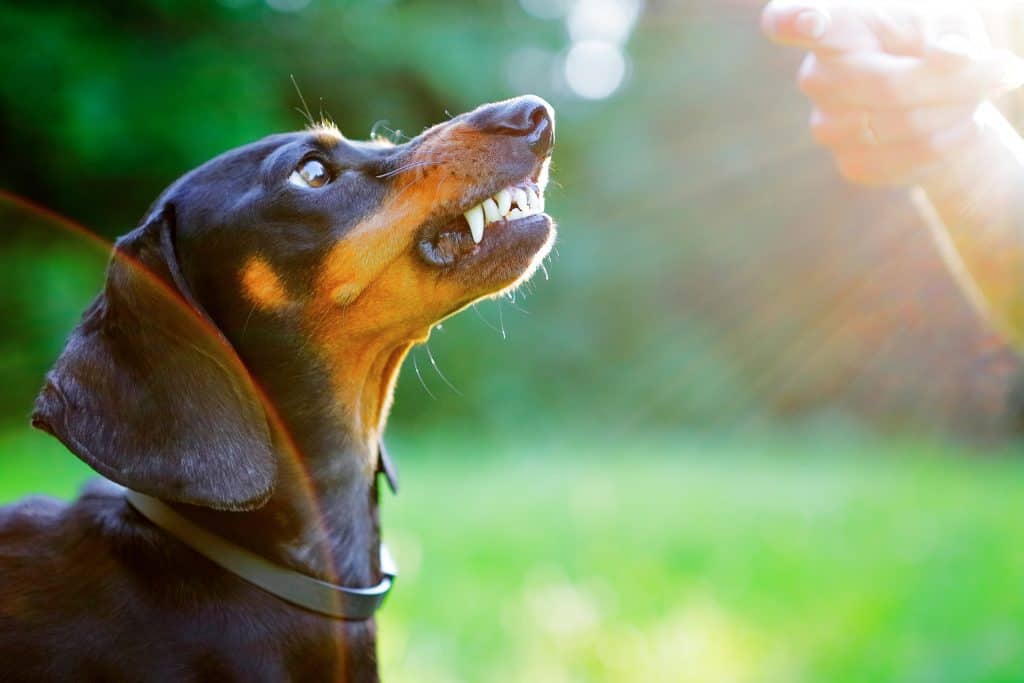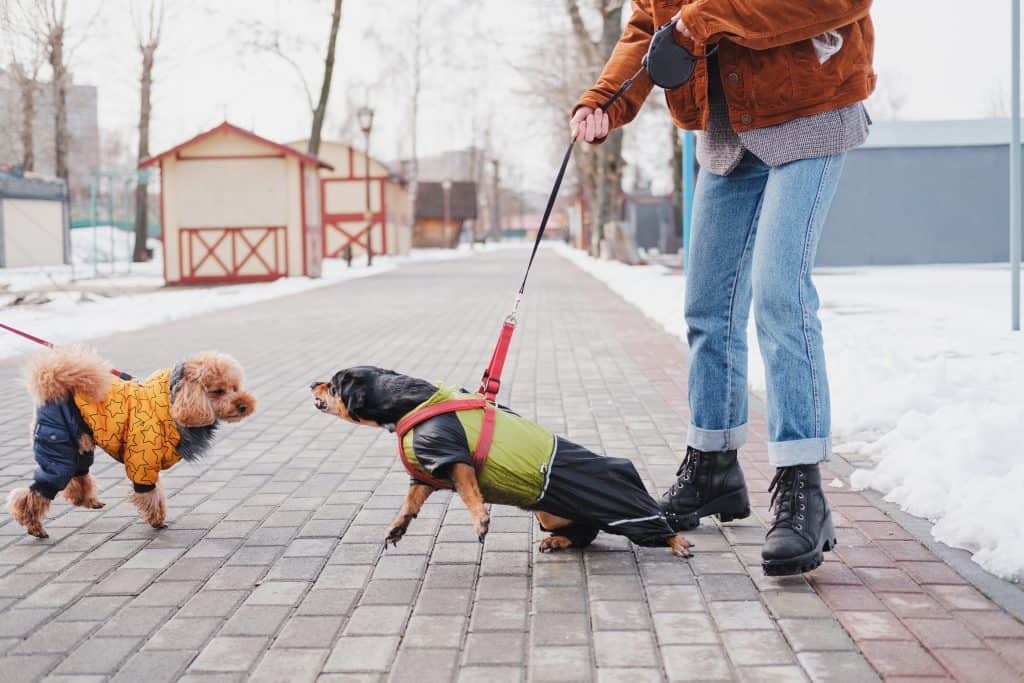Aggression in dachshunds can be distressing for owners, but with patience and knowledge, it can be addressed effectively. Let’s delve into recognizing signs of aggression and practical steps to correct this behavior.
Related post: Are dachshunds aggressive?

Signs of Aggression in Dachshunds:
Dachshunds, like any breed, can display various signs of aggression. It’s essential to recognize these signs early to address any underlying issues and prevent potentially harmful situations. Here are some common signs of aggression in Dachshunds:
- Growling: Growling is a vocal warning sign that your Dachshund may be feeling threatened or defensive. It’s crucial to pay attention to growling and address the underlying cause to prevent escalation.
- Snapping or Biting: Aggressive Dachshunds may exhibit snapping or biting behavior, especially when they feel cornered, scared, or provoked. This behavior can be dangerous and requires immediate intervention.
- Showing Teeth: Baring teeth is a clear sign of aggression in dogs. If your Dachshund is displaying this behavior, it’s essential to take steps to de-escalate the situation and address the root cause of their aggression.
- Stiff Body Language: Aggressive Dachshunds may display stiff body language, including rigid posture, raised hackles (the hair along the back), and a tense facial expression. These physical cues indicate that your dog is feeling threatened or on edge.
- Lunging or Charging: Some aggressive Dachshunds may lunge or charge at perceived threats, whether they’re other animals, people, or objects. This behavior can be dangerous and requires immediate intervention to prevent harm.
- Resource Guarding: Dachshunds may exhibit aggression when guarding valuable resources such as food, toys, or sleeping areas. This behavior can escalate if not addressed promptly and may require professional guidance to manage effectively.
- Avoidance or Withdrawal: In some cases, Dachshunds may display aggression as a defensive response to feeling overwhelmed or scared. This can manifest as avoidance behavior, where the dog tries to retreat or hide from perceived threats.
- Excessive Barking: While barking is a natural form of communication for dogs, excessive or prolonged barking can indicate underlying stress, fear, or aggression in Dachshunds.
- Freezing or Staring: Aggressive Dachshunds may freeze or stare intently at their target before exhibiting aggressive behavior. This intense focus can be a precursor to snapping, lunging, or biting.
For more detailed signs, refer to the ASPCA’s article on aggression
Handling Dachshund Aggression:
Training a Dachshund to stop being aggressive requires patience, consistency, and positive reinforcement. Here’s a step-by-step guide to help you train your Dachshund:
- Identify Triggers: Observe your Dachshund to understand what triggers their aggression. It could be certain people, animals, objects, or situations.
- Create a Safe Environment: Manage your Dachshund’s environment to avoid triggering situations whenever possible. For example, if your dog becomes aggressive around certain dogs, keep them on a leash or separate them until they are trained to behave calmly.
- Positive Reinforcement: Use positive reinforcement techniques to encourage desired behavior. When your Dachshund behaves calmly and non-aggressively, reward them with treats, praise, or toys. This helps reinforce the idea that good behavior is rewarded.
- Desensitization and Counterconditioning: Gradually expose your Dachshund to the triggers of their aggression in a controlled setting while providing positive experiences. For example, if your dog is aggressive towards strangers, start by introducing them to calm and friendly strangers from a distance, then gradually decrease the distance over time.
- Redirect Aggressive Behavior: When your Dachshund displays aggressive behavior, redirect their attention to a more appropriate behavior, such as sitting or lying down. Use treats or toys to distract them and reward them for the desired behavior.
- Avoid Punishment: Avoid using punishment-based methods as they can escalate aggression and damage the trust between you and your dog. Instead, focus on positive reinforcement to encourage good behavior.
- Seek Professional Help: If your Dachshund’s aggression is severe or persistent, consider seeking help from a professional dog trainer or behaviorist. They can provide personalized guidance and support tailored to your dog’s specific needs.
- Exercise and Mental Stimulation: Ensure your Dachshund gets enough physical exercise and mental stimulation to prevent boredom and frustration, which can contribute to aggression. Engage in regular walks, playtime, and training sessions to keep them mentally and physically healthy.
- Consider Using a Muzzle: A muzzle can prevent accidents and protect others from aggressive behavior.
- Explore CBD Oil: CBD oil can help reduce anxiety and pain in dogs, potentially reducing aggressive tendencies.
- Patience and Persistence: Changing behavior takes time, so be patient and persistent in your training efforts. Celebrate small victories along the way and remain consistent in your approach.
- Consistency: Be consistent in your training approach and expectations. Everyone in the household should follow the same rules and training techniques to avoid confusion.
Related Post: Are Dachshunds Easy to Train?

Causes and Types of Aggression:
Aggression in Dachshunds can stem from various underlying causes, and it can manifest in different types depending on the context and triggers. Understanding the causes and types of aggression is crucial for effectively addressing and managing your Dachshund’s behavior. Here are some common causes and types of aggression in Dachshunds:
Causes of Aggression:
- Fear: Aggression can be a defensive response to perceived threats or situations that cause fear or anxiety in Dachshunds. This type of aggression often occurs when dogs feel cornered or overwhelmed.
- Territoriality: Dachshunds are known to be territorial, and they may exhibit aggression towards perceived intruders or threats to their territory, such as other dogs or unfamiliar people.
- Resource Guarding: Aggression can arise when Dachshunds feel the need to protect valuable resources such as food, toys, or sleeping areas from perceived threats.
- Lack of Socialization: Insufficient socialization during puppyhood can lead to fear-based aggression toward unfamiliar people, animals, or environments in Dachshunds.
- Pain or Discomfort: Dogs may display aggression as a response to pain or discomfort caused by underlying health issues such as injuries, dental problems, or arthritis.
- Predatory Instincts: Dachshunds have a strong prey drive, and they may exhibit aggressive behavior towards smaller animals or objects that trigger their hunting instincts.
- Frustration: Aggression can occur when Dachshunds become frustrated or unable to access desired resources or engage in specific behaviors.
Related post: How To Relax A Dog
Types of Aggression:
- Fear Aggression: This type of aggression occurs when Dachshunds feel threatened or scared, leading them to exhibit defensive behaviors such as growling, snapping, or fleeing.
- Territorial Aggression: Dachshunds may display territorial aggression towards perceived intruders, whether they’re other animals or unfamiliar people entering their territory.
- Dominance Aggression: Some Dachshunds may exhibit aggression as a means of asserting dominance over other animals or people, particularly in multi-pet households.
- Redirected Aggression: This occurs when Dachshunds redirect their aggression toward an unintended target, often due to frustration or arousal from another source.
- Resource Guarding Aggression: Aggression can arise when Dachshunds feel the need to protect valuable resources such as food, toys, or sleeping areas from perceived threats.
- Predatory Aggression: Dachshunds may exhibit predatory aggression towards smaller animals or objects, driven by their natural hunting instincts.
- Pain-Induced Aggression: Aggression can be a response to pain or discomfort caused by underlying health issues, prompting Dachshunds to lash out defensively.
Understanding the underlying causes and types of aggression in Dachshunds is essential for implementing appropriate training, management, and behavior modification techniques. Seeking guidance from a professional dog trainer or behaviorist can help address aggression effectively and ensure the safety and well-being of your Dachshund and those around them.
Related post: Why Dachshunds Bark So Much?

Conclusion
Training an aggressive dachshund requires patience and understanding. By implementing positive reinforcement and seeking professional guidance when needed, you can help your furry friend become a well-behaved companion.
Remember, every dog is unique, and progress may take time. Stay committed, and your efforts will pay off in creating a harmonious bond with your dachshund.
Related post: Dachshund Training Guide: Tips & Tutorials to Train a Dachshund
Recent Posts
Calculate the perfect food portions for your dachshund with our specialized calculator. Get customized feeding recommendations based on size, age, and activity level to support your wiener dog's back...
Looking for the perfect gift for a proud dachshund mom? We’ve rounded up the cutest dachshund shirts that celebrate your love for wiener dogs in style. Whether you’re shopping for yourself or a...



